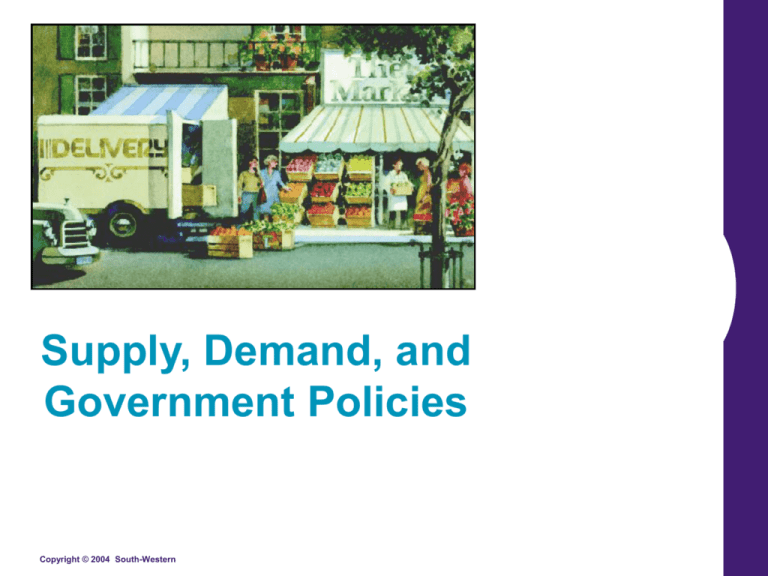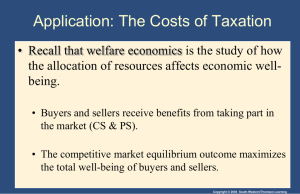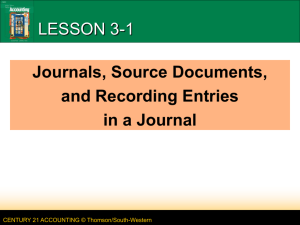Price Floor
advertisement

Supply, Demand, and Government Policies Copyright © 2004 South-Western Supply, Demand, and Government Policies • In a free, unregulated market system, market forces establish equilibrium prices and exchange quantities. • While equilibrium conditions may be efficient, it may be true that not everyone is satisfied. • One of the roles of economists is to use their theories to assist in the development of policies. Copyright © 2004 South-Western/Thomson Learning CONTROLS ON PRICES • Are usually enacted when policymakers believe the market price is unfair to buyers or sellers. • Result in government-created price ceilings and floors. Copyright © 2004 South-Western/Thomson Learning CONTROLS ON PRICES • Price Ceiling • A legal maximum on the price at which a good can be sold. • Price Floor • A legal minimum on the price at which a good can be sold. Copyright © 2004 South-Western/Thomson Learning How Price Ceilings Affect Market Outcomes • Two outcomes are possible when the government imposes a price ceiling: • The price ceiling is not binding if set above the equilibrium price. • The price ceiling is binding if set below the equilibrium price, leading to a shortage. Copyright © 2004 South-Western/Thomson Learning How Price Ceilings Affect Market Outcomes • Effects of Price Ceilings • A binding price ceiling creates • shortages because QD > QS. • Example: Gasoline shortage of the 1970s • nonprice rationing • Examples: Long lines, discrimination by sellers Copyright © 2004 South-Western/Thomson Learning CASE STUDY: Lines at the Gas Pump • In 1973, OPEC raised the price of crude oil in world markets. Crude oil is the major input in gasoline, so the higher oil prices reduced the supply of gasoline. • What was responsible for the long gas lines? • Economists blame government regulations that limited the price oil companies could charge for gasoline. Copyright © 2004 South-Western/Thomson Learning CASE STUDY: Rent Control in the Short Run and Long Run • Rent controls are ceilings placed on the rents that landlords may charge their tenants. • The goal of rent control policy is to help the poor by making housing more affordable. • One economist called rent control “the best way to destroy a city, other than bombing.” Copyright © 2004 South-Western/Thomson Learning How Price Floors Affect Market Outcomes • When the government imposes a price floor, two outcomes are possible. • The price floor is not binding if set below the equilibrium price. • The price floor is binding if set above the equilibrium price, leading to a surplus. Copyright © 2004 South-Western/Thomson Learning How Price Floors Affect Market Outcomes • A price floor prevents supply and demand from moving toward the equilibrium price and quantity. • When the market price hits the floor, it can fall no further, and the market price equals the floor price. Copyright © 2004 South-Western/Thomson Learning How Price Floors Affect Market Outcomes • A binding price floor causes . . . • a surplus because QS > QD. • nonprice rationing is an alternative mechanism for rationing the good, using discrimination criteria. • Examples: The minimum wage, agricultural price supports Copyright © 2004 South-Western/Thomson Learning The Minimum Wage • An important example of a price floor is the minimum wage. Minimum wage laws dictate the lowest price possible for labor that any employer may pay. Copyright © 2004 South-Western/Thomson Learning TAXES • Governments levy taxes to raise revenue for public projects. Copyright © 2004 South-Western/Thomson Learning How Taxes on Buyers (and Sellers) Affect Market Outcomes • Taxes discourage market activity. • When a good is taxed, the quantity sold is smaller. • Buyers and sellers share the tax burden. Copyright © 2004 South-Western/Thomson Learning Elasticity and Tax Incidence • Tax incidence is the manner in which the burden of a tax is shared among participants in a market. Copyright © 2004 South-Western/Thomson Learning Elasticity and Tax Incidence • Tax incidence is the study of who bears the burden of a tax. • Taxes result in a change in market equilibrium. • Buyers pay more and sellers receive less, regardless of whom the tax is levied on. Copyright © 2004 South-Western/Thomson Learning Elasticity and Tax Incidence • What was the impact of tax? • Taxes discourage market activity. • When a good is taxed, the quantity sold is smaller. • Buyers and sellers share the tax burden. Copyright © 2004 South-Western/Thomson Learning Figure 8 A Payroll Tax Wage Labor supply Wage firms pay Tax wedge Wage without tax Wage workers receive Labor demand 0 Quantity of Labor Copyright©2003 Southwestern/Thomson Learning Elasticity and Tax Incidence • In what proportions is the burden of the tax divided? • How do the effects of taxes on sellers compare to those levied on buyers? • The answers to these questions depend on the elasticity of demand and the elasticity of supply. Copyright © 2004 South-Western/Thomson Learning ELASTICITY AND TAX INCIDENCE So, how is the burden of the tax divided? • The burden of a tax falls more heavily on the side of the market that is less elastic. Copyright © 2004 South-Western/Thomson Learning Summary • Price controls include price ceilings and price floors. • A price ceiling is a legal maximum on the price of a good or service. An example is rent control. • A price floor is a legal minimum on the price of a good or a service. An example is the minimum wage. Copyright © 2004 South-Western/Thomson Learning Summary • Taxes are used to raise revenue for public purposes. • When the government levies a tax on a good, the equilibrium quantity of the good falls. • A tax on a good places a wedge between the price paid by buyers and the price received by sellers. Copyright © 2004 South-Western/Thomson Learning Summary • The incidence of a tax refers to who bears the burden of a tax. • The incidence of a tax does not depend on whether the tax is levied on buyers or sellers. • The incidence of the tax depends on the price elasticities of supply and demand. • The burden tends to fall on the side of the market that is less elastic. Copyright © 2004 South-Western/Thomson Learning








